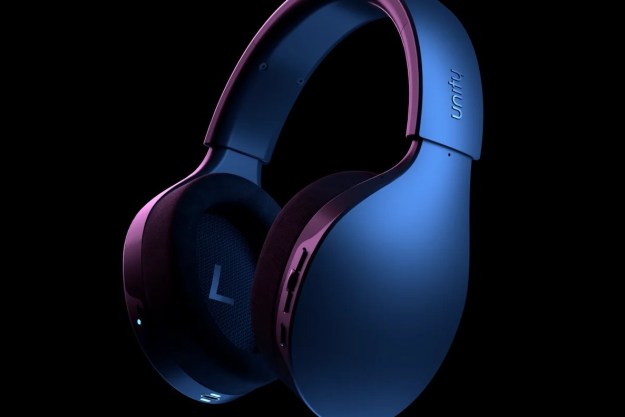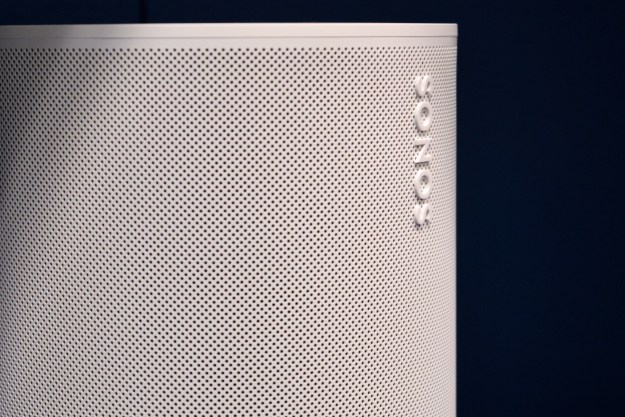A deep dive into a German patent application published in August 2021 reveals that Sonos is considering a set of wireless headphones that could work over Wi-Fi as well as Bluetooth. Should Sonos launch a set of headphones with Wi-Fi capability, it would be the first of its kind and give Sonos users an unprecedented level of control over their music both at home and on the go.
Here’s what we know:
Rumors that Sonos plans to release its own wireless headphones and/or wireless earbuds have been swirling for years. And while several designs have surfaced — again, thanks to images found in patent applications — little has been discovered about how these headphones or earbuds might be functionally different from existing products from companies like Sony, Bose, and Apple. Within a German patent application titled “Cable retraction mechanism for headphone devices,” though, lies this highly revealing statement:
[…] a consumer expects from Wi-Fi-enabled headphones the same type of reliable internet connection to their wireless access point that they experience when using a tablet […] — translated from German by Google Translate
While a patent application doesn’t mean that new tech is imminent, it would seem to be the biggest indicator we have to date that Sonos doesn’t intend to simply launch a set of conventional Bluetooth headphones. Why is this important detail included in a patent seemingly related to cable retraction and not Wi-Fi? It turns out that if you want to build a set of reliable Wi-Fi-enabled headphones, you need an antenna system that goes well beyond the engineering requirements of a Bluetooth device.

Another antenna needed
According to the application, a set of Bluetooth headphones can get away with a single antenna, housed in one of the two headphone earcups. Because of this, a very thin, audio-only cable can be used to connect the secondary earcup to the primary earcup. That cable can be easily routed through the headband and earcup forks without fear of damage, even as the headphone earcups are extended and retracted to suit people’s various head sizes.
To add Wi-Fi connectivity — with the same level of range and reliability you’d expect from a phone or tablet — antennas need to be placed in both earcups because the human head has a tendency to block Wi-Fi signals. The problem is that it’ll now need to pass both audio and Wi-Fi antenna signals from one earcup to another, and that requires a thicker cable that effectively insulates the different internal wires from each other. A thicker cable also creates real issues when it comes to running it between earcups while simultaneously letting the earcups move in and out of the headband. Kinks, bends, and other points of possible damage could seriously degrade the life span of this thicker cable.
[…] a cable assembly containing each of the required conductors for the improved wireless headphones discussed in the examples described herein may be greater than 4 mm in diameter. This is almost twice the diameter of a typical headband cable in a Bluetooth-only headphone […] — translated from German by Google Translate
The main body of the patent describes the various ways in which Sonos plans to overcome this challenge. Its main strategy appears to combine a serpentine routing pattern through the headband with a cable material made from elastomeric plastic. Such a cable could be heat-formed into that accordion-like shape and would also possess the necessary elasticity to pull itself back into shape after being extended for long periods of time.
Why Wi-Fi?
Why may Sonos be going through all of this trouble to add Wi-Fi to a set of wireless headphones when the rest of the industry appears content to rely on Bluetooth?
First, Wi-Fi has much bigger bandwidth capacities than Bluetooth. Bluetooth is great for sending lossy, compressed audio over short distances. But even with the latest version (Bluetooth 5.2) and the use of high-quality codecs like aptX HD, LDAC, and LHDC, support for truly lossless, hi-res audio at something like 24-bit/192kHz remains well out of reach. Wi-Fi can deliver these audio signals without breaking a sweat.
This additional wireless audio fidelity may not do you much good when you’re out and about in the hustle-and-bustle of life. But at home, it could provide true audiophile-grade sound to a set of wireless headphones, which is something the high end of the market has been wanting.
Second is that the entire Sonos ecosystem of wireless connected speakers is based on Wi-Fi. While it’s true that the Sonos Roam and Sonos Move portable speakers have Bluetooth connections, too, Wi-Fi remains the backbone of the Sonos experience. And, for now, its powerful and elegant app for iOS, Android, and computers only controls Wi-Fi devices — it doesn’t work when the Roam or Move are set to Bluetooth mode, for instance.
So while companies like Apple and Sony understand the audio quality advantages of Wi-Fi, they don’t have the same ecosystem-driven incentive to create Wi-Fi-enabled headphones that Sonos does. If and when Sonos launches these headphones, it could be the first to let Apple Music listeners hear the full range of Apple’s lossless audio catalog on a set of wireless headphones.
Is a new cable the only challenge?
No. The patent application referenced above details how Sonos intends to manage the thicker cable needed for Wi-Fi, but a bigger challenge is the fact that Wi-Fi requires much more power than Bluetooth. More power means either a bigger battery in order to provide the same listening time as Bluetooth, or the same size of battery but with a much shorter listening time.
Still, given that we’ve seen Bluetooth headphones with a 45- to 50-hour capacity, shortening this listening time by 50% in order to provide Wi-Fi seems like a pretty good trade-off.
These power requirements might explain another Sonos patent that emerged in 2021 and illustrated a set of true wireless earbuds that come equipped with a set of magnetically attached power plates designed to extend listening time, even while wearing the earbuds.
What about Bluetooth?
Any wireless headphones that Sonos releases will have to support Bluetooth as well as Wi-Fi, and it’s looking like Sonos wants to be a leader in the Bluetooth space. The company recently acquired Bluetooth audio startup T2 Software, according to Protocol, which has been working on ways products can integrate the next generation of Bluetooth: Bluetooth LE Audio.
Bluetooth LE Audio brings a new Bluetooth codec, known as LC3, which promised higher quality audio with much lower power consumption. It also adds the concept of public and private “shared streams” — the ability to stream Bluetooth from one sending device to multiple receiving devices. Gaining expertise in this area will give Sonos an edge, not only as it relates to any wireless headphones it creates, but also when it comes to better integrating Bluetooth speakers into its Wi-Fi-only multiroom ecosystem. Shared streams could essentially reproduce Sonos’ Wi-Fi audio distribution using Bluetooth instead.
Price and availability
So far, we have no reliable information regarding when (or even if) Sonos will launch a set of Wi-Fi-enabled headphones. But given that patent applications tend to lag actual product development — when a company actually intends on selling a product that uses the tech described in the patent — it’s possible that Sonos could announce these new headphones later in 2022. Supply chain issues, which have delayed many products over 2020/21, could push this back as far as 2023.
In terms of price, the consensus seems to be that Sonos will ask up to $500, putting its headphones in direct competition with the $549 Apple AirPods Max and well above the price of the $349 Sony WH-1000XM4 and $399 Bose Noise Cancelling Headphones 700. Assuming that Sonos includes all the usual bells and whistles, though, like active noise cancellation (ANC), transparency, Bluetooth Multipoint, and wear sensors, it could easily justify its higher price through the inclusion of Wi-Fi and Sonos app control, which would make it truly unique in the market.
Editors' Recommendations
- Sony’s ULT Power Sound headphones and speakers go big on powerful bass
- Sonos says new product (probably headphones) coming by fall
- Sonos headphones to make 2024 debut, and a video streaming device is set for 2025
- Sonos Move 2: Sonos’ biggest portable speaker gets a big update
- Sonos problems? A new Wi-Fi router might be the answer







